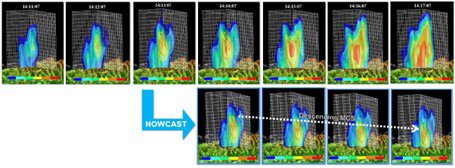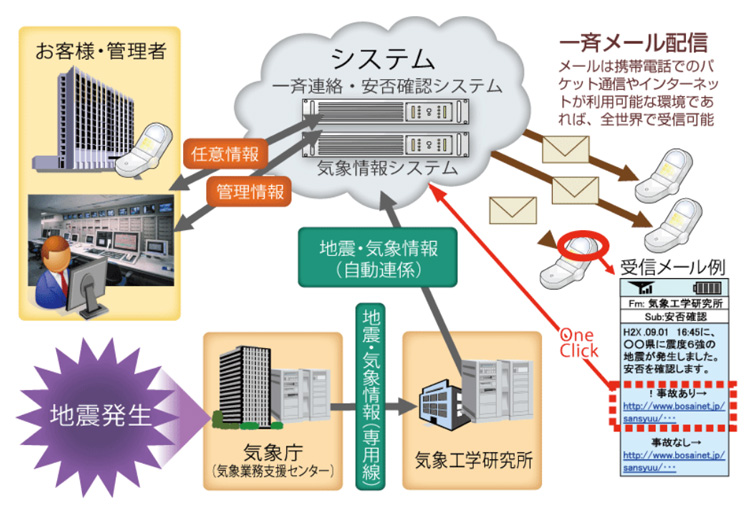Development of Various Forecasting Systems That Contribute to Climate Change Adaptation
Meteorological Engineering Center, Inc.
Industry: Academic research, professional and technical services
| Publication date | October 5, 2023 (Posted on May 23, 2024) |
|---|---|
| Sector | Natural Disasters / Coastal Areas / Life of Citizenry and Urban Life |
Company Overview

The Meteorological Engineering Center, Inc. was established in 2004 to contribute to the safety and security of society through "meteorological engineering," a new research and technology development field that integrates meteorology as a science with engineering processes such as observation, data processing, and modeling, in order to meet society's needs related to weather, including rain, wind, temperature, snow, lightning, pollen, and extreme and sudden weather events.
Climate Change Impacts
Recently, localized torrential rains have been occurring frequently throughout Japan, causing tremendous damage to local communities. The need for accurate rainfall forecasts and other meteorological information is increasing for national and local government agencies to make appropriate decisions when issuing evacuation advisories for river basins and operating and managing dams.
Adaptation Initiatives
The Meteorological Engineering Center provides various services related to meteorological engineering and weather information that contribute to climate change adaptation. The following are some examples.
■"Localized heavy rainfall forecasting system using PAWR" (Fig. 1)
This is a method for forecasting localized heavy rainfall that has been occurring frequently in recent years, focusing on the fact that it is possible to forecast the three-dimensional movement of precipitation cells by utilizing ultra-high resolution spatiotemporal rainfall distribution information (updated every 30 seconds, horizontal resolution: 100 m, elevation angle: 100) using PAWR (Phased Array Weather Radar). The system is updated every 30 seconds and forecasts rainfall up to 30 minutes in advance.
■Lightning strike forecasting system "Kaminar" (Fig. 2)
Based on the abundant lightning strike data accumulated by the Kansai Electric Power Company, Inc. and the latest weather data, the system forecast the probability of lightning strikes. The forecast information is available online, so the users can access the information from their computer and other devices.
■Simultaneous communication and safety confirmation system "Anpis" (Fig. 3)
Using cell phones/the Internet and automatically linked to weather information, this system makes it possible to simultaneously contact all relevant individuals and confirm their safety in the event of a disaster. Other customized real-time weather forecasting and display systems developed by the Disaster Prevention Research Institute, Kyoto University include Temporon, a new temperature forecasting system; Solarion, a solar radiation forecasting system; Thermian, a heat stroke forecasting system; and Windon, a wind direction and wind speed forecasting system.
Effects / Expected Benefits
From the standpoint of meteorological engineering, we contribute to ensuring the safety and security of local communities and residents by providing real-time risk management information for disaster prevention and mitigation, as well as detailed varying infrastructure information such as information related to lifestyle and health including sports, tourism, shopping, and other activities.



- Meteorological Engineering Research Center, Inc. (only available in Japanese)
- Meteorological Engineering Research Center, Inc. "Introduction of Companies Headed for Kansai Expo 2025" - Aiming to Create Disaster-Resistant Event Venues with the World's First Prediction System Using Phased Array Weather Radar (only available in Japanese)
- Meteorological Engineering Research Center, Inc. "Lightning strike prediction system, Kaminar" (only available in Japanese)
- Meteorological Engineering Research Center, Inc. "Simultaneous communication and safety confirmation system, Anpis" (only available in Japanese)
- Meteorological Engineering Research Center, Inc. "New temperature forecasting system, Temporon" (only available in Japanese)
- Meteorological Engineering Research Center, Inc. "Solar radiation prediction system, Solarion" (only available in Japanese)
- Meteorological Engineering Research Center, Inc. "Heat stroke prediction system, Thermian" (only available in Japanese)
- Meteorological Engineering Research Center, Inc. "Wind direction and wind speed prediction system, Windon" (only available in Japanese)

